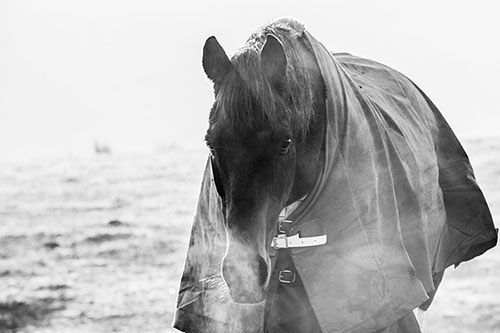
The decision of whether to rug a horse plagues a significant number of horse owners, particularly when the weather becomes colder. Many of them would most likely unpack turnout and stable rugs for their horses at the same time that they take out their fleeces and jumpers to keep themselves warm. However, horses do not experience the same discomfort from cold temperatures as people, so would they require turnout rugs?
Why Horses Need Turnout Rugs
<p;> A horse's thermo-neutral zone is significantly larger than a human's, so the freezing winter cold does not affect it as much as it does us. Horses also generate heat through thermoregulation and are very good at retaining that heat. On the other hand, when the temperature drops, the horse's hair stands on end, creating a barrier that traps heat. If you have a clipped horse, you might require an additional gram or two of a rug to act as a warmth shield.
A turnout rug is a great investment as it will not only keep the horse warm but will also keep the horse clean, preventing it from getting wet and losing heat. There are varying degrees of defense and warmth that a rug provides, and the Kentucky turnout rug is ideal for all kinds of weather. The vast selection of turnout rugs is not only fashionable but also practical, and they can help keep your horse comfortable no matter what the weather is like.
Factors to Consider When Buying a Turnout Rug for Your Horse
The ideal turnout rug will prevent the horse from getting cold and wet in the field. In addition, it will offer a layer of protection against the elements. The following is a list of considerations to make before making a purchase of a turnout rug for your horse.
1. Weight
You can choose light, medium, or heavy weights for your turnout rug, depending on your needs. Lightweight coats are adequate for the spring and fall seasons, while medium and heavyweight coats are more appropriate for the cold season.
2. Construction
It is also important to consider the general construction and design of the rug, in addition to the type of materials used. Some rugs come with removable stacks or quilts to adapt to varying temperatures and humidity levels.
The level of warmth provided by the rug is directly proportional to the quantity of the filling. The outer layer of a turnout rug must be resilient enough to protect the horse from the elements and other potential dangers, such as other horses' teeth and thorns bushes.
3. Color and Style
The objective of turnouts is to provide a horse with as much warmth as possible by enveloping it in a protective sheath. Many offer various cut options to cover the horse's entire body. For milder climates, the distinctive neckline finishes at the shoulders.
With a high-neck rug, the finish is higher, creating a snugger feel, and helping to keep rain from seeping down the neck and inside the rug's shoulder area. You can also get a 'combo' rug with full padding at the neck for maximum coverage.
Wrapping Up
Using a turnout rug, you can keep your horse comfortable and dry in adverse weather. Your horse can run around in these rugs without worrying about them coming loose. A turnout is also a nice respite from the relentless summer heat and annoying insects.
You can find more articles in our section on English & Western Tack.
































